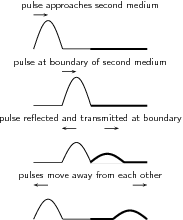| << Chapter < Page | Chapter >> Page > |
What happens when a pulse travelling in one medium finds that medium is joined to another?
Find two different ropes and tie both ropes together. Hold the joined ropes horizontally and create a pulse by flicking the rope up and down. What happens to the pulse when it encounters the join?
When a pulse is transmitted from one medium to another, like from a thin rope to a thicker one, the nature of the pulse will change where it meets the boundary of the two media (i.e. where the two ropes are joined). Part of the pulse will be reflected and part of it will be transmitted. [link] shows the general case of a pulse meeting a boundary. The incident pulse is the one that arrives at the boundary. The reflected pulse is the one that moves back, away from the boundary. The transmitted pulse is the one that moves into the new medium, away from the boundary. The speed of the pulse depends on the mass of the rope; the pulse is faster in the thinner rope and slower in the thick rope. When the speed of the pulse increases, the pulse length will increase. If the speed decreases, the pulse length will decrease.

Consider a pulse moving from a thin rope to a thick rope. As the pulse crosses the boundary, the speed of the pulse will decrease as it moves into the thicker rope. The pulse will move slower, so the pulse length will decrease. The pulse will be reflected and inverted in the thin rope. The reflected pulse will have the same length and speed but will have a smaller amplitude. This is illustrated in [link] .

When a pulse moves from a thick rope to a thin rope, the opposite will happen. As the pulse crosses the boundary, the speed of the pulse will increase as it moves into the thinner rope. The pulse in the thin rope will move faster, so the pulse length will increase. The pulse will be reflected but not inverted in the thick rope. The reflected pulse will have the same length and speed but will have a smaller amplitude. This is illustrated in [link]


Notification Switch
Would you like to follow the 'Siyavula textbooks: grade 10 physical science' conversation and receive update notifications?